Oil and Gas Well Drilling and Servicing eTool
Servicing » Special Services

Special services are operations that use specialized equipment and workers who perform support well drilling and servicing operations.
Coordination between all personnel is critical for site safety. Therefore, all special services operations should conduct a pre-job safety meeting to include all personnel on the job site.
Hazards related to special services may include:
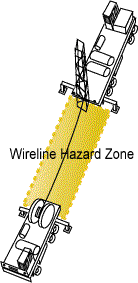



All wireline operations require special precautions. Wireline operations may include slick line and electric line operations. Operations completed through the use of wireline include logging, perforating, setting of downhole tools, fishing, bailing, and swabbing.
Note: The special service supervisor should hold a pre-job meeting with the special service crew and other involved personnel to review responsibilities and to coordinate the operations to be performed.
Potential Hazard
- Being struck by wireline due to line failure.
Possible Solutions
- Keep all non-essential workers out of the immediate work area.
- Inspect wireline, rope sockets, and cable heads for defects before use.
- Operate the wireline at a safe speed.
- Use an appropriate method to determine the end of line location.
Potential Hazards
- Being struck by wireline, lubricator, sheaves, or other equipment.
- Getting caught in wireline.
Possible Solutions
- Keep all non-essential workers out of the immediate work area.
- Inspect all slings, chains, pins or other attachment devices before lifting or suspending tools or equipment.
Potential Hazards
- Pinching hands and fingers.
- Getting sprains, strains or suffering from overexertion.
Possible Solutions:
- Minimize manual handling of lubricators and other equipment.
- Use proper hand placement and tag lines to avoid pinch points.
Potential Hazards
- Falling from a height.
- Receiving burns or being exposed to a respiratory hazard due to a fire.
Possible Solutions
- Use proper fall protection.
- Position the unit properly with respect to wind direction and distance from potential gas or vapor sources [RP 54, Recommended Practice for Occupational Safety for Oil and Gas Well Drilling and Servicing Operations, Wireline Service. American Petroleum Institute (API), (2007, March)].
Potential Hazard
- Being exposed to an unexpected release of pressure.
Possible Solutions
- Install a pressure release valve in the lubricator sub.
- Bleed pressure from lubricator sub before breaking connections.
- Check for an unusually tight connection that may indicate that pressure has not been released.
Potential Hazard
- Toppling mast or boom.
Possible Solution
- Install foundation, outriggers, and guying according to the manufacturer's recommendations.
Additional Information
- Standards. American Petroleum Institute (API).
- RP 54, Occupational Safety for Oil and Gas Well Drilling and Servicing Operations. (March 2007).

Well logging is used to identify formation and other downhole properties of the well bore.
Logging tools can include radioactive, electric, mechanical, and sonic tools, among others.
Note: See also Wireline Operations and Perforating for descriptions of additional hazards.
Potential Hazard
- Being exposed to radiation.
Possible Solutions
- Keep non-essential workers away from the rig floor and marked-off areas where radiation hazards may be present.
- Wear appropriate personnel protective equipment (PPE).
- Allow only authorized and qualified logging company personnel to handle the logging tools.
- Report any damage to radioactive logging tools.
Potential Hazards
- Getting injured due to an unexpected release of pressure.
Possible Solutions
- Check for the presence of trapped pressure before opening the tool housing.

Additional Information
- Ionizing Radiation. OSHA Safety and Health Topics Page.
- 10 CFR 39, Licenses and Radiation Safety Requirements for Well Logging. Nuclear Regulatory Commission (NRC).
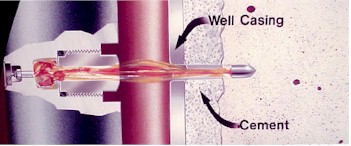
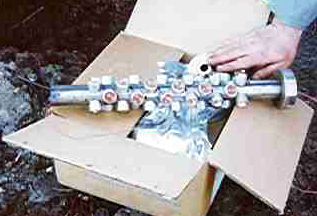
A specialized crew transports and operates the perforating equipment. Upon arrival to the site, the tools are assembled, then lowered into the well by a wireline unit or conveyed by tubing. Then, a specialized gun shoots small holes into the casing of the producing zone.
The perforations allow the oil or gas to flow into the casing or liner. If pressure is sufficient, the oil or gas will rise to the surface.
Detailed operational procedures and trained personnel are necessary for the safe handling of explosives. The solutions below illustrate possible solutions; for more detailed information see Additional Information below.
Note: The special service supervisor should hold a pre-job meeting with the special service crew and other involved personnel to review responsibilities and coordinate the operations to be performed.
Potential Hazard
- Surface detonation of explosives.
Possible Solutions
- Keep all non-essential personnel out of the immediate work area.
- Post warning signs and prohibit the use of radios, telephones, or navigational systems.
- Shut down non-essential electrical systems during gun-arming operations.
- Perform operations involving explosives under the direct supervision of the special services supervisor.
- Report any suspected remnants of explosives to the special services supervisor.
Additional Information
- Standards. American Petroleum Institute (API).
- RP 54, Occupational Safety for Oil and Gas Well Drilling and Servicing Operations. (March 2007).
- RP 67, Recommended Practice for Oilfield Explosives Safety. American Petroleum Institute (API)
- Wireline Operations and Procedures. American Petroleum Institute (API).
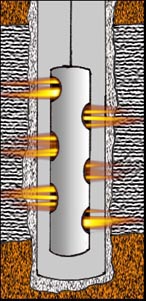

Cementing and pumping operations may be performed by specialized pumping services or in conjunction with well servicing operations (such as, casing, squeezing, and zone isolations). The hazards involved will vary with mode of dry cement delivery and mixing as well as the primary designed function of the pumping equipment.
Note: The special service supervisor should hold a pre-job meeting with the special service crew and other involved personnel to review responsibilities and coordinate the operations to be performed.
Rig Up - Spotting and assembly of equipment to perform cementing or pumping operations.
Potential Hazards
- Being struck by moving vehicles.
- Being exposed to potential ignition and respiratory hazards.
- Overexerting, or getting sprains and strains.
- Being exposed to pinch points (for example, hammer union wings and hammers, pump iron and racks).
- Being hit by flying particles.
- Falling from heights.
- Slips, trips, and falls.
- Being struck by falling equipment.
Possible Solutions
- Preplan equipment locations and use a spotter(s) to position equipment out of fall lane of the derrick and upwind of vapor and gas sources.
- Use mechanical lifting aids, proper lifting techniques, and team lifting where appropriate.
- Use proper hand and body positioning.
- Wear appropriate personal protective equipment including fall protection and respiratory protection.
- Conduct a pre-job inspection to identify, then eliminate or correct hazardous work surfaces.
- Require all non-essential personnel to stand clear.
- Secure all elevated lines.
Pumping - Executing the job
Potential Hazards
- Being struck by high pressure lines or unexpected release of pressure (due to, mismatched or excessively worn hammer unions, line failure).
- Being exposed to chemical hazards (such as, silica, toxic liquids, and gases).
- Being exposed to high noise levels.
- Slips, trips, and falls.
- Overexerting, or receiving sprains and strains while handling materials (such as sacks and buckets).
Possible Solutions
- Direct all non-essential personnel to stand clear.
- Require pump operator to stay by the controls.
- Conduct adequate pressure tests on pump(s) and lines before pumping. [RP 54, Recommended Practice for Occupational Safety for Oil and Gas Well Drilling and Servicing Operations, Wireline Service. American Petroleum Institute (API), (2007, March)].
- Hobble high-pressure lines properly.
- Use proper equipment inspection techniques to include hammer unions (Note: This is a particular problem with 602 and 1502, as they will couple but will not hold beyond the lower pressure rating number).
- High Pressure Lines and Hammer Unions. International Association of Drilling Contractors (IADC) Alert 98-01, (1998).
- More On Mismatched Hammer Unions. International Association of Drilling Contractors (IADC) Alert 99-33, (1999).
- Additional Serious Incidents With Mismatched Hammer Unions. International Association of Drilling Contractors (IADC) Alert 00-15, (2000).
- Wear appropriate personal protective equipment (for example, respiratory, skin, and hearing) for the hazards present.
- Conduct a pre-job inspection to identify, then eliminate or correct hazardous work surfaces.
- Use mechanical lifting aids, proper lifting techniques, and team lifting where appropriate.
Rig Down - Disassembly and demobilization of equipment
Potential Hazards
- Being struck by moving vehicles.
- Being exposed to potential ignition and respiratory hazards.
- Overexerting or receiving sprains and strains.
- Being exposed to pinch points (such as, hammer union wings and hammers, pump iron and racks).
- Being hit by flying particles.
- Falling from heights.
- Slips, trips, and falls.
- Being struck by falling equipment.
Possible Solutions
- Use a spotter(s) to direct equipment movement.
- Use mechanical lifting aids, proper lifting techniques, and team lifting where appropriate.
- Use proper hand and body positioning.
- Wear appropriate personal protective equipment including fall protection and respiratory protection.
- Conduct a post-job inspection to identify, then eliminate or correct hazardous work surfaces.
- Require all non-essential personnel to stand clear.
Additional Information
- See the Personal Protective Equipment and Dermal Exposure Safety Health Topics Pages.

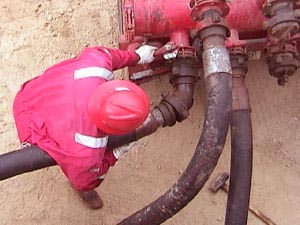
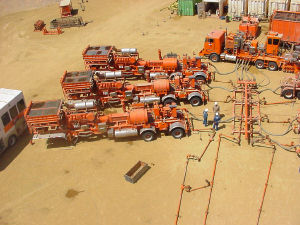
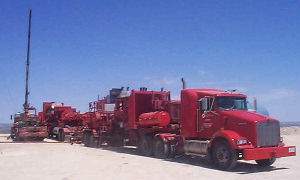
Well stimulation involves techniques to optimize well performance. This may include pumping of acids, energized fluids, and various other chemicals to improve formation flow characteristics.
Note: The special service supervisor should hold a pre-job meeting with the special service crew and other involved personnel to review responsibilities and to coordinate the operations to be performed.
Note: When pumping energized fluids (such as, carbon dioxide or liquid nitrogen) substantial increased hazards exist related to asphyxiation, temperature extremes, and unexpected pressure releases. Use special procedures to ensure the safety of personnel.
Rig Up - Spotting and assembly of equipment to perform stimulation operations.
Potential Hazards
- Being struck by moving vehicles.
- Being exposed to potential ignition and respiratory hazards.
- Overexerting or receiving sprains and strains.
- Being exposed to pinch points (such as, hammer union wings and hammers, pump iron and racks).
- Being hit by flying particles.
- Falling from heights.
- Slips, trips, and falls.
- Being struck by falling equipment.
- Being injured due to potential ignition of flammable or combustible carrier or base fluids.
Possible Solutions
- Preplan equipment locations and use a spotter(s) to position equipment out of fall lane of the derrick and upwind of vents, vapor and gas sources.
- Use mechanical lifting aids, proper lifting techniques, and team lifting where appropriate.
- Use proper hand and body positioning.
- Wear appropriate personal protective equipment including fall protection and respiratory protection.
- Conduct a pre-job inspection to identify, then eliminate or correct hazardous work surfaces.
- Require all non-essential personnel to stand clear.
- Secure all elevated lines.
- Provide adequate bonding and grounding for blending, pumping and sand transfer equipment.
- Use hose covers or shielding for transfer or suction lines containing flammable liquids.
Pumping - Executing the job
Potential Hazards
- Being struck by high-pressure lines or unexpected release of pressure (for example, mismatched or excessively worn hammer unions, line failure).
- Being exposed to chemical hazards (such as, silica, toxics, asphyxiants).
- Being exposed to high noise levels.
- Slips, trips, and falls.
- Overexerting or receiving sprains and strains while handling materials (such as sacks and buckets).
- Being exposed to temperature extremes.
- Being exposed to radiation associated with radioactive tracer materials.
Possible Solutions
- Require all non-essential personnel to stand clear.
- Direct equipment operators to stay by their controls.
- Conduct adequate pressure tests on pump(s) and lines and ensure proper valve alignment before pumping. Install a check valve as close to the well head as possible [RP 54, Recommended Practice for Occupational Safety for Oil and Gas Well Drilling and Servicing Operations, Wireline Service. American Petroleum Institute (API), (March 2007)].
- Hobble high pressure lines properly.
- Use proper equipment inspection techniques to include hammer unions (Note: This is a particular problem with 602 and 1502, as they will couple but will not hold beyond the lower pressure rating number).
- High Pressure Lines and Hammer Unions. International Association of Drilling Contractors (IADC) Alert 98-01, (1998).
- More On Mismatched Hammer Unions. International Association of Drilling Contractors (IADC) Alert 99-33, (1999).
- Additional Serious Incidents With Mismatched Hammer Unions. International Association of Drilling Contractors (IADC) Alert 00-15, (2000).
- Wear appropriate personal protective equipment (for example, respiratory, skin, and hearing) for the hazards present.
- Conduct a pre-job inspection to identify, then eliminate or correct hazardous work surfaces.
- Use mechanical lifting aids, proper lifting techniques, and team lifting where appropriate.
- Keep non-essential personnel away from marked-off areas where radiation hazards may be present.
- Allow only authorized and qualified company personnel to handle radioactive tracer materials or radioactive densiometers.
- Prevent contamination and exercise proper personal hygiene when working around radioactive materials.
Rig Down - Disassembly and demobilization of equipment
Potential Hazards
- Being struck by moving vehicles.
- Being exposed to potential ignition hazards, including flammable or combustible liquids or gases.
- Being exposed to potential skin and respiratory hazards.
- Overexerting or receiving sprains and strains.
- Being exposed to pinch points (such as, hammer union wings and hammers, pump iron and racks).
- Being struck by particles or fluid.
- Falling from heights.
- Slips, trips, and falls.
- Being struck by falling equipment.
- Being injured due to the unexpected release of trapped pressure.
Possible Solutions
- Use a spotter(s) to direct equipment movement.
- Use mechanical lifting aids, proper lifting techniques, and team lifting where appropriate.
- Use proper hand and body positioning.
- Wear appropriate personal protective equipment (for example, respiratory, skin, and hearing) for the hazards present.
- Conduct a post-job inspection to identify, then eliminate or correct hazardous work surfaces.
- Direct all non-essential personnel to stand clear.
- Follow procedures to release trapped pressure safely.
Additional Information
- See the Personal Protective Equipment and Dermal Exposure OSHA Safety and Health Topics Pages.


Swabbing is the act of pulling fluid from the well bore through the use of wire rope and cup assembly. Swabbing equipment includes a swabbing assembly, lubricator with an oil saver, and shut-off valve on the well, also called a swabbing valve.
General precautions during all swabbing operations:
- Conduct swabbing operations during daylight hours.
- Keep all personnel clear of the derrick or within six feet (two meters) of the wellhead during swabbing operations.
- Locate swab tanks at least 100 feet (30 meters) from the well, where location allows.
Potential Hazard
- Loss of well control.
Possible Solutions
- Use appropriate equipment, rated for the expected pressures, to shut in the well.
- Inspect lubricators, swages, and unions for defects such as cuts, corrosion, and thread damage before use.
- Adjust oil savers by remote control with a hydraulic pump placed safely away from the wellhead.
- Train all personnel in emergency evacuation procedures.
Potential Hazard
- Fire, explosive, or respiratory hazard from leakage or venting of oil or gas from tanks, lines or lubricator.
Possible Solutions
- Place fire extinguishers in accessible positions.
- Move sources of potential ignition (such as, open fires for melting of babbitt) to designated areas at a safe distance from the wellhead or flammable liquid storage areas such as the swab tank before swabbing.
- Make provisions to contain spilled flammable liquids.
- Monitor the oil saver for wear and potential leakage.
- Remove all spillage of flammable liquids from equipment, cellars, rig floor, and ground area adjacent to the wellhead.
- Wear proper personal protective equipment, including respiratory protection, as required.
Potential Hazards
- Being struck by a pressurized line.
- Being exposed to a high-pressure connection failure caused by mismatched or excessively worn hammer unions.
Possible Solutions
- Avoid approaching, walking over or standing near pressurized lines.
- Securely anchor pressurized lines to prevent whipping or bouncing caused by pressure surges.
- Use proper equipment inspection techniques to include hammer unions (Note: This is a particular problem with 602 and 1502 and others, as they will couple but will not hold beyond the lower pressure rating number).
- High Pressure Lines and Hammer Unions. International Association of Drilling Contractors (IADC) Alert 98-01, (1998).
- More On Mismatched Hammer Unions. International Association of Drilling Contractors (IADC) Alert 99-33, (1999).
- Additional Serious Incidents With Mismatched Hammer Unions. International Association of Drilling Contractors (IADC) Alert 00-15, (2000).
Potential Hazards
- Being struck by pressurized fluids or the lubricator when removing the lubricator from the well.
- Getting strains and sprains from handling the lubricator.
Possible Solutions
- Close the shut-off valve and bleed the pressure from the lubricator before removing it.
- Use a lubricator that will allow removal of the swab or other tools with the well shut in (valve closed).
- Use a dolly or other method to minimize manual handling of the equipment.
Potential Hazard
- Pinching fingers between swab assembly and lubricator when changing swab cups or mandrels.
Possible Solutions
- Use a winch line, where available, not the swab line, to handle the lubricator.
- Use a lubricator that will allow removal of the swab or other tools with the well shut in (valve closed).
Additional Information
- Standards. American Petroleum Institute (API).
- RP 54, Occupational Safety for Oil and Gas Well Drilling and Servicing Operations. (March 2007).
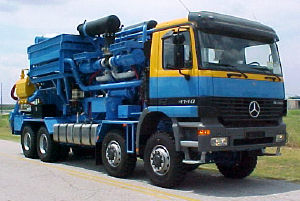
A hot oil unit is designed to circulate heated fluid into piping, tubing, casing, or tanks for a variety of reasons, including the removal of paraffin and tar-based oils.
Potential Hazard
- Fire or explosion hazard from contact with flammable liquids, vapors, or gases.
Possible Solutions
- Locate hot oil trucks and tanks a safe distance (100 feet is recommended) from the well and out of the fall line of the derrick, if it is on site. Where impractical, use additional safety measures.
- Position hot oil units upwind or crosswind from potential sources of flammable liquids, vapors, or gasses. Wind direction indicator should be present and visible to the operator.
- Shut down hot oiling operation immediately if a leak occurs.
- Make fire extinguishers readily accessible to the hot oil operator.
- Avoid parking over or placing lines containing flammable fluids under trucks or other vehicles.
- Install check valve in the pump line as close to the well head as possible.
- Inspect all components of the hot oil unit before each use.
- Shut the burner down if the wind dies.
- Shut the burner down and reposition equipment if the wind changes direction so as to create a hazard.
Potential Hazard
- Being burned by hot oil or hot oil line or frostbite injuries from contact with propane or propane lines.
Possible Solution
- Wear appropriate personnel protective equipment such as heavy padded, insulated, leather gloves.
Potential Hazards: Expert Review
- Unexpected release of pressure.
Possible Solutions
- Do not connect heavy joints of pipe to the small nipples on the pumping T.
- Secure all hot oil and discharge lines.
- Connect the hot oil line directly to the flow line if pump pressure exceeds safe limits (500 psi).
- Remain clear of pressurized lines.



Snubbing is the control of a tubing string while running it in or out of a well bore under pressure.
Note: The special service supervisor should hold a pre-job meeting with the special service crew and other involved personnel to review responsibilities and to coordinate the operations to be performed.
Potential Hazards
- Falling from heights.
- Being exposed to an unexpected release of pressure, and loss of well control.
- Being burned by a fire and explosion.
- Having limited ingress and egress.
- Working in an unstable basket due to lack of guy wires.
- Being caught between the rig assist pull down and crows nest.
Possible Solutions
- Ensure proper fall protection.
- Inspect and maintain all pressure control equipment prior to operations.
- Provide adequate means of access to and exit from the basket.
- Provide emergency escape method [RP 54, Recommended Practice for Occupational Safety for Oil and Gas Well Drilling and Servicing Operations, Wireline Service. American Petroleum Institute (API), (March 2007)].
- Rig all equipment in accordance with equipment recommendations.
- Ensure proper body and hand placement.


Technology allows tubing to be manufactured in a continuous coil without joints. Coiled tubing is inserted into the well down the production casing without the need for tongs, slips, or elevators.
Potential Hazards
- Pinching fingers and hands.
- Being exposed to an unexpected release of pressure.
- Getting struck by falling or shifting objects (such as suspended injector heads).
- Falling from heights.
Possible Solutions
- Keep all fingers and hands away from pinch points (such as tubing spool, rollers, injector head).
- Inspect the tools and equipment before use.
- Rig up boom trucks in accordance with manufacturer's recommendations.
- Use fall protection.

